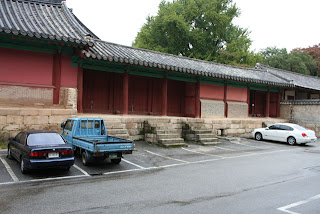Sung Kyun Kwan University
So as part of the process of learning about our new home, I've been reading a few books on Korea and her people. One of them is The Koreans by Michael Breen. It's a pretty good treatise on how Koreans think, and I highly recommend it. A few pages in, I came across a rather tantalizing tidbit:
"So much tourism potential is ignored. For example, Sung-kyun-kwan University in Seoul is the oldest university in the world in terms of a set of standing buildings. The classrooms, offices and library built in the fourteenth century are still there. No tour groups ever visit them. "
Well I certainly couldn't let that go, and so on a rainy morning I tossed a camera into the backpack and hopped onto the subway. A few steps later I emerged into a pretty familiar scene: the College Town. The dong surrounding Sung Kyun Kwan University has all of the hallmarks of this apparently worldwide phenomenon: stalls and stores offering cheap food, furniture, and music. It was almost like being back home, except I can't really read the signs yet.
A few wrong turns later and I arrived at the gates; as Breen says, there is no special attention paid to Seonggyungwan; it sits quietly on campus, mostly obscured by trees. In fact, I almost missed it. As I walked through a parking lot located behind a shiny new academic building, I stumbled across 600-year old stairs descending solemnly into the macadam.
paid to Seonggyungwan; it sits quietly on campus, mostly obscured by trees. In fact, I almost missed it. As I walked through a parking lot located behind a shiny new academic building, I stumbled across 600-year old stairs descending solemnly into the macadam.
Originally built in the 1300s, this compound was last rebuilt in 1601 after a fire. In any other country that I've visited, there would be walls around it, an interpretive museum, and an admission fee. Here, you can just kind of wander in through any open gate. I did so. The buildings are all well-maintained, and these days appears that the compound is primarily used as a quad by the students here. Damp as it was today, I almost had the place to myself.
I did so. The buildings are all well-maintained, and these days appears that the compound is primarily used as a quad by the students here. Damp as it was today, I almost had the place to myself.
There's definitely something awesome about using a site like this as a place for students to hang out, socialize, and study.. and I certainly can't complain about the accessibility. That said, I'd still like to see such an important site get a little more attention, especially from Koreans.
Koreans don't really care much about their ancient roots, or at least that's the impression that I've been getting from both the Koreans I've spoken with, as well as the various authors I've read on the subject. Everything is focused on bootstrapping the country into an economic powerhouse; Koreans seem to have little attention to spare contemplating their ancient heritage. Maybe part of my reaction stems from the fact that, as an American, I'm kind of jealous that Korea has this sort of history sitting around; we certainly have nothing like this where I come from.
I've been getting from both the Koreans I've spoken with, as well as the various authors I've read on the subject. Everything is focused on bootstrapping the country into an economic powerhouse; Koreans seem to have little attention to spare contemplating their ancient heritage. Maybe part of my reaction stems from the fact that, as an American, I'm kind of jealous that Korea has this sort of history sitting around; we certainly have nothing like this where I come from.
This particular site has been preserved, but many aren't. Domestic tourism to ancient temples and palaces is perfunctory at best; even downtown, most of these sites aren't even lit at night. Korea strikes me as being where Japan was in the 1960s, many feel that they too were focused on economic growth and ignored their cultural sites; as a result, many of them are gone now. Kyoto is a sad example of this; many visitors are shocked at what has happened to that once-beautiful city. I hope that Korea avoids the same mistake; I hope that these treasures are still around when she finally decides to catch her breath.


0 comments:
Post a Comment